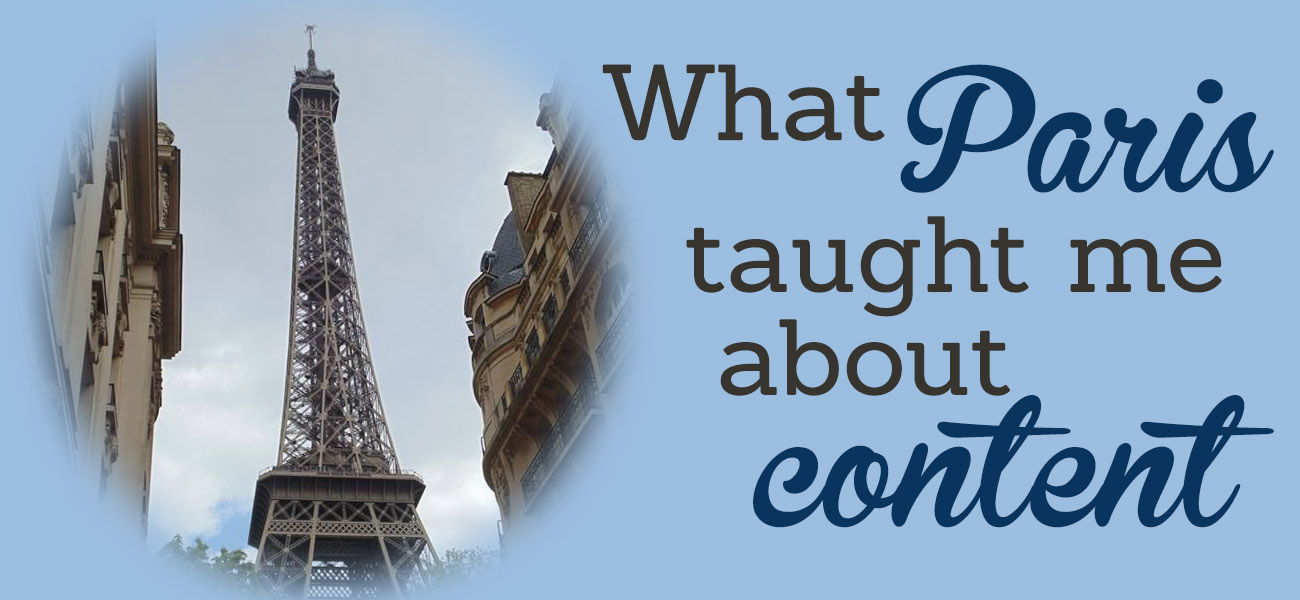What Paris Taught Me About Content

As EVG’s Digital Media Coordinator, I’m well aware of the importance of content marketing—from the relevance of your brand to user-generated content to SEO. I understand why knowing your audience is imperative when crafting content and developing promotions.
Being a tourist in Paris, however, gave me a new perspective. This time, I was that audience in a new way—I had to plan a trip in a city I was largely unfamiliar with. There were many businesses that pulled me in or pushed me away based on content. Content wasn’t just a job—it was everything.
So, what can you learn from my trip to Paris?
User-Generated Content
Many businesses are afraid of a little UGC—with good reason. A bad review can deter consumers. At the same time, good reviews will bring more business. In Paris, reviews were a huge deciding factor in where I ate and what sights I saw.
Typically, when researching a restaurant, I relied on Yelp or TripAdvisor. What did the reviews say? Were customers satisfied with the food? What were the complaints? I could ignore “bad service” complaints (waiters in France are very different from waiters in the States) and I could ignore “very crowded” reviews (a good restaurant in Paris is bound to be crowded). I could also ignore the random 1 star review in a series of 4/5 star reviews (generally someone who was bitter for silly reasons).
I used the same concept to narrow down places to visit. The Louvre, though full of stunning works of art, was eventually decided against. My traveling companion and I had both been before, and reviews I looked at often cited the enormous size of the museum and how overwhelming it was. Instead, we chose the Museé Cluny (a smaller Middle Ages museum), Tour Jean Sans Peur (a medieval tower) and the Museé de la Vie Romantique (a tiny museum on the romantic period). It was thanks to online reviews and the experiences of others that we picked these museums over an afternoon in the Louvre.
Don’t shy away from user-generated content. If you believe in your business and your content, let others who also believe in it speak up! Invite people to leave reviews, and if there’s a bad review, don’t delete it. Users nowadays like to see the real sides of companies. So someone had bad service at your restaurant. If your restaurant is as awesome as you know it to be, the good reviews will outweigh the bad. And if you take the time to respond to those bad reviews and attempt to remedy the situation, you build a rapport of good customer service.
As a tourist who was unfamiliar with local businesses, user-generated content was the deciding factor in where I went and where I decided not to go. Don’t discount its importance.
Relevant Content
I was trying to find how much it cost to go up the Arc de Triomphe a few weeks ago. First off, there are two websites, the actual Arc de Triomphe website and a National French Monuments website. They list different prices. The National French Monuments websites also says that there is a reduced rate ticket for 6€, but it doesn’t say who is eligible for that. This annoying lack of info/competing info was enough for me to put the Arc de Triomphe on the “maybe” list (side note: we did wind up going because we had unforeseen extra time. Turns out that I was eligible for the 6€ ticket (it was for people under 26), and the price on the Arc de Triomphe website itself was wrong).
There were a few restaurants that I was looking at but I couldn’t find anything about cost. This was enough of an annoyance to not bother going to those restaurants. Money is important—especially for tourists like me, who do not have an indispensible income and are looking to stay within a strict budget. Without knowing how much these restaurants cost, I didn’t want to risk traipsing across the city only to find that it’s 50€ a plate and I can’t afford it.
Information for visitors should be easy to find and shouldn’t conflict with other websites. If you think your info is easy to find, test it out—ask someone to try to find specific things (cost, hours, location, etc.). Time them on how long it takes and how easy it really is.
Content marketing means making your content easily accessible and creating a smooth user experience—otherwise, you’re going to push your audience away.
Appealing Content
Content isn’t just what’s on your website or in your reviews. A museum with a clearly marked entrance, a restaurant with a nicely designed menu for passersby to glance at, free pamphlets with information in French, English, and Italian—all of this is content marketing, and all of it is going to draw more of your audience in.
When we were trying to decide where to eat, a clearly labeled and nicely designed menu made a difference. If there were people outside, how their food looked made a difference. The atmosphere of the restaurant made a difference. Branding made a difference.
This is content marketing, and it isn’t just online. The content at your place of business, the signage of the monument or the pamphlet that is offered at a museum, all of that is important. Content is everything, and you must be sure that your audience gets what they want and need.
Vanessa Levin-Pompetzki – Digital Media Coordinator



